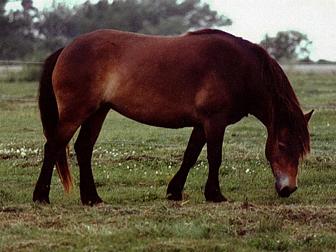
OVERVIEW
As the name implies, these ponies come from the Exmoor region, a wild moorland in the South West of England. The Exmoor is the oldest British pony, and possibly as old as any horse breed. With a few peculiarities found only in the Exmoor, namely a seventh molar tooth and unique jaw formation, its ancient background is well founded. The breed most likely ran wild after the Roman invasions when its native running ground was left uninhabited for hundreds of years. The pony has been used recently as a children's pony, and are also strong enough to carry a smaller adult. They can be used in harness and, when crossed with Thoroughbreds, make excellent hunters.
PHYSICAL DESCRIPTION
The breed standards for the Exmoor call for the height of its stallions and geldings not to exceed 12.3 hh at any age, and mares not to exceed 12.2 hh at any age. Of definite pony appearance, the Exmoor is hard and strong with a symmetrical outline and alert presence. Known to withstand harsh climates, the Exmoor has a hooded "toad" eye, long nasal passage to warm air with inhalation, and an "ice" tail, feathered at the base for added protection. The Exmoor usually appears in bay, brown, or dun coloration with black points and a mealy muzzle.
ORIGIN
Being Britain's oldest pony, the Exmoor's influences are limited to a single postulated ancient pony type: Pony Type 1, originating in northwest Europe it was highly resistant to wet conditions. This origination is significantly proven by the fossilized remains of Celtic ponies found in Alaska with the same unique jaw type as the Exmoor's. More presently, the Exmoor has been found in representations from the Bronze Age as a chariot pony. A slab created during Roman times shows a pony with a clear "toad" eye. In the Bayeux Tapestry, an embroidery dated back to around 1066 and representing the story of the Norman Conquest, shows a pony with a very strong resemblance to the Exmoor carrying a warrior. By the 1700s the Exmoor was being kept for hunting and farm use. Today there are only three herds running on the Moor, and, although bred throughout the country, these herds are regularly tapped to keep character.
INTERESTING FACTS
The purebred Exmoor Pony remain relatively wild, although they are herded and brought in for inspection and branding once a year. Attempts to breed the Exmoor outside of its natural state have met with little success, causing breeders to constantly return to the wild herds for feral blood. Two types of Exmoor exist today: the Acland type (a family in which a large portion of the Exmoor herd was left in the 1800s) closely resembling the physical character described above, and the Withypool type, a slightly larger, darker pony with a straighter profile.
INFLUENCES
1. Celtic Pony
For more information:
Exmoor Pony Society
Listed as "Critical" by The American Livestock Breeds Conservancy (2004)